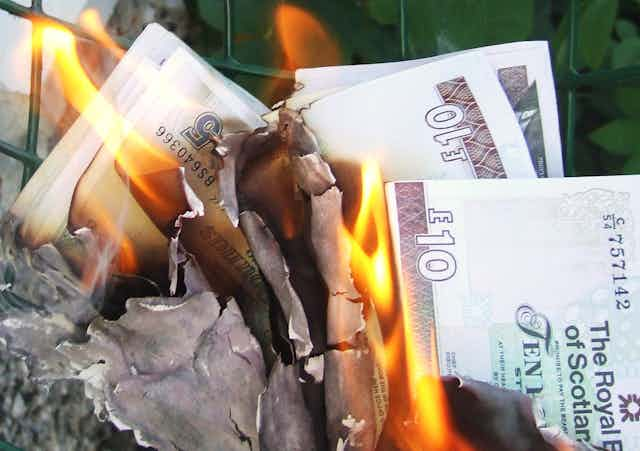While Edinburgh and London wrestle over the future of the pound, it has has been sinking. The slide (especially against the US dollar) is widely seen as a knee-jerk reaction to the possibility of Scotland voting for independence on September 18, and the 2-3 years of economic uncertainty that might follow as it wrangles over constitutional and monetary arrangements with the rest of the UK. Without these complications it seems unlikely that the pound would be tracking the euro downwards, with interest rates falling in the Eurozone and soon to rise in the UK.
But there’s a longer-term view, reinforced in July by the International Monetary Fund, that sterling needs to fall 5-10% – regardless of the referendum result – to correct a longstanding overvaluation. This is based on UK imports continuing to substantially outweigh exports, resulting in a current-account deficit equivalent to more than 5% of national output despite improvement towards the end of 2013.
Wishful sinking?
Such deficits can’t be sustained without an ongoing inflow of foreign capital, and the disruption to those flows played a major part in triggering the UK’s worst post-war recession in 2008-9. Their persistence causes uneasiness over the government’s claim to have created a “balanced” recovery. Letting the exchange rate weaken, to make imports more expensive and exports cheaper abroad, can help to re-balance the current account, provided demand is responsive enough to the price changes at home and abroad.

Some currency analysts are convinced that the pound is ripe for a sharp fall, and that a shock like Scottish secession could be the cue. But as there’s much randomness in currency movements, no-one can say precisely when it will happen, or which shock will be the decisive one. To argue that it’s got to drop now, because it’s been overvalued so long, may be to commit a well-known judgemental error, (the “gambler’s fallacy”).
Many eminent economists had convinced themselves in 2006-7 that the US, with a similarly wide and chronic external deficit, was in imminent danger of a sharp dollar depreciation. The US then received a gigantic unanticipated shock in the shape of a sub-prime mortgage crisis and the dollar gained strength, as investors around the world seized on it as the best way to protect their embattled capital. Similar dynamics persuade some analysts that sterling is destined to stay strong, and may even rise in the wake of a Scottish “Yes” vote.
Like the US, the UK has run wide current-account deficits for many years because of its unwavering ability to attract foreign capital. In part, that’s because it has long been the EU’s biggest attractor of foreign direct investment. Little dented by the crisis of 2008, that attractiveness is now magnified as the UK’s medium-term growth rates move above the Eurozone’s.
Unwanted appreciation?
A breakaway by Scotland might actually strengthen this tide of inward investment, as worried Scottish businesses and wealth managers shift their assets southwards. There is a disaster scenario for England in which Scotland snatches the oil wealth without taking any of the national debt, leaving the remaining UK with endemic fiscal and trade deficits which make it permanently slow-growing and inflation-prone. But financial markets may be more alert to the nightmare scenario for the new independent Scotland.
This occurs if the remaining UK sticks to its cross-party threat of excluding the renegades from the present monetary union. Scotland might then be left with an invidious choice. It could let the pound circulate without controlling the monetary policies that affect exchange rates and credit growth, a policy that risks limiting the fiscal discretion which is a principal motive for pursuing independence. It could join the Eurozone, whose long-term stability is still unclear and which would impose its own fiscal curbs. And it could launch an independent Scottish currency, whose likely depreciation against sterling might boost the economy but also fuel inflation. That might put a big premium on Scottish borrowing costs, especially if the finance minister carries out his threat not to take on any of the present UK national debt - a move some lenders might construe as default even if lawyers do not.
Without the Bank of England as its lender of last resort, the independent government might be deemed incapable of underpinning a large banking system (whose assets are ten times its GDP, a ratio no EU country except Luxembourg has survived with, according to a hotly disputed UK government analysis). The banks (led by Lloyds and RBS), and other large holders of capital, might then seek an alternative place of safety. The most likely direction of unsettled funds would be into UK government bonds and other sterling assets. Scotland’s interest rates would inevitably rise as its new masters sought to stem the capital flight.
The prospect of Scotland’s capital clinging to the union while its people march out might inspire Westminster’s embattled “No” campaigners in the run-up to the vote. But if the pound rallies in anticipation of such developments, it will endanger a UK recovery already endangered by the pressure on its exporters. Ironically, downward pressure on sterling due to a messy and protracted referendum aftermath could be the trade-boosting gift that present and future Chancellors in Westminster are seeking, despite their professed desire for a decisive result.

